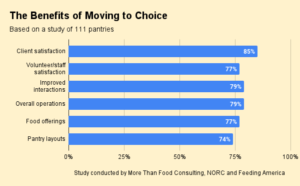As a former chef and restaurant owner, Greg Silverman knows a thing or two about how to get the best food at the best price. That knowledge helped him reduce by nearly 20% the cost of purchasing food for the mega-pantry he runs and three other pantries, all in New York City.
Knowing that better prices come with volume, Silverman, who is Executive Director of the West Side Campaign Against Hunger, in mid-2018 assembled a collective of four large, NYC-based pantries to share food purchasing and invoice information. The motivation was the same as for any good chef: to affordably acquire greater volumes of better-tasting, healthy food, in this case fresh produce, lean protein and milk.
“We knew we could easily find strong savings by purchasing together,” Silverman explained. “The goal was to use the savings to get more great food.”
In the end, the collective, which together serves more than 5.7 million meals annually and spends about $1.2 million a year on food (exclusive of grants), did not even need to enter into formal group purchasing arrangements to achieve meaningful savings. Simply by sharing data and analyzing purchases for a year across all four organizations, the group gained insights into wide disparities in vendor pricing and used that knowledge to negotiate more competitive pricing overall.
For example, the collective found that the price of a quart of milk varied from an average of $1.17 from one vendor, to $0.79 from another. When one of the pantries, which had been paying $2.79 for milk quarts, opted for the lowest-cost option, it saved 71.7%.
Overall, the group collectively saved 19% on purchases made during the six months of the pilot, amounting to more than $68,000, according to an invoice analysis performed by NYC-based Karen Karp & Partners. That amount far exceeded the 5% savings that the group, which also included New York Common Pantry, Project Hospitality and St. John’s Bread and Life, had hoped to achieve. Extrapolated annually, the 19% savings amounts to more than $160,000.
While the project imposed extra work on the pantries, it also afforded them welcome opportunities to collaborate. Regular communication between the pantries led them to exchange information beyond vendor pricing, such as about technology platforms and human resources practices, to the benefit of all. “We didn’t realize how excited and engaged each partner would be about working together,” Silverman said.
During the project, each pantry entered a full year’s worth of food-purchasing invoice data into a consistent digital format, requiring substantial staff time. The group then met three times to analyze the data and discuss opportunities for improved purchasing. During the purchasing portion of the pilot, the pantries submitted invoices to Karen Karp & Partners, which logged and analyzed them. Representatives from each pantry also completed bi-weekly (and later monthly) surveys about their new vendor relationships and participated in monthly conference calls to discuss progress and challenges.
Going forward, the group is looking to bring four more organizations into the collective and take steps to become self-sustaining, such as by having each pantry contribute a small annual amount (perhaps $1,000 to $7,000) to participate. Philanthropy from Robin Hood, Sea Change Capital and New York State Health Foundation supported the first round of the collective’s activities, and additional philanthropy will be sought to support a second round, which could encompass shared warehouse space and human resources functions, as well as collaborative approaches to food rescue.
Silverman came to West Side Campaign Against Hunger about three years ago, after holding positions in nutrition education and emergency food distribution in Washington D.C. and London. Earlier in his career, he owned restaurants in Ithaca, NY, and spent time in the Peace Corps in Mali.
In Silverman’s view, pantries and their clients deserve to benefit from the same types of strategies more often deployed in the for-profit restaurant world. “I feel very strongly that we’re doing this to fight hunger,” he said. “I refuse not to use every tool at our disposal to make sure our clients get the best service possible.”
For a detailed overview of the Collective Purchasing Project, click here.
CAPTION FOR PHOTO ABOVE: Greg Silverman in the storage area of the West Side Campaign Against Hunger.
Connect with Us:














